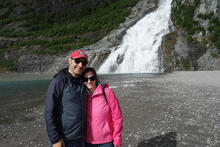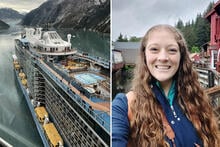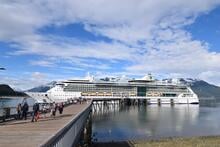If you’re planning a cruise to Alaska, there are 10 things you definitely want to know before you book.

Cruising to Alaska is extremely popular, but not all cruise passengers know what to expect. An Alaska cruise can vary depending on the month you sail, itinerary you book, and ship you select for your vacation, among other factors.
Before booking, it’s helpful to be prepared for any potential surprises. The weather might not be as cold as you imagined, or your dream shore excursion could be more costly than you expected.
These are the top 10 things to know before you book an Alaska cruise so that you’re prepared for the trip of a lifetime.
The time of year you sail can impact your cruise experience

The Alaska cruise season runs from May to September each year, and your experience in the state can vary from month to month.
Weather, daylight hours, wildlife viewing opportunities, and crowds change frequently throughout the Alaska cruise season. During the summer, you’ll find the warmest temperatures and most daylight, but, by far, the most crowds.
Related: The Best Month To Visit Alaska on a Royal Caribbean Cruise
Likewise, fall brings lower prices and crowds, but also less daylight and fewer wildlife viewing opportunities.
While there’s no “right” month to cruise Alaska, you should research what to expect in each month. No time of the year will be perfect in all criteria, but certain months may work better with your travel preferences than others.
It won’t always be cold (the weather is unpredictable)
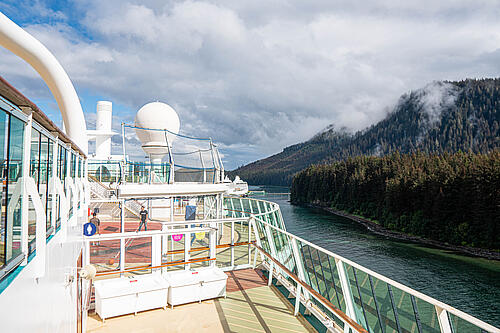
When most people think of an Alaska cruise, they imagine chilly temperatures, snow, and glaciers. Because of this, many passengers are surprised when they feel warm (or even sweat) on an Alaska cruise.
You might be surprised with how warm you feel in Alaska, especially if you’re traveling between June and August. On warm summer days, it’s possible to see temperatures in the mid 60s which, under the sun, feels fairly hot.
While packing t-shirts, shorts, and sandals for an Alaska cruise might seem odd, you might wear these items more frequently than you think. Even though the mornings can be chilly, temperatures may rise quickly throughout the day, leaving you uncomfortable in a sweater and rain jacket.
Related: Alaska cruise packing list: What to pack for your sailing

If you booked an active shore excursion, such as a cycling or hiking tour, you may feel uncomfortably warm in heavy layers. In this case, having thin layers like short sleeve shirts and lightweight shorts or pants is helpful.
Of course, you could prepare for warm weather and encounter nothing but rain and freezing temperatures during your cruise. In a state like Alaska, it’s possible to see several seasons in one day, and weather is relatively unpredictable.
Packing layers ensures you’re prepared for whichever weather conditions you encounter.
Book a one-way itinerary if you want to extend your trip
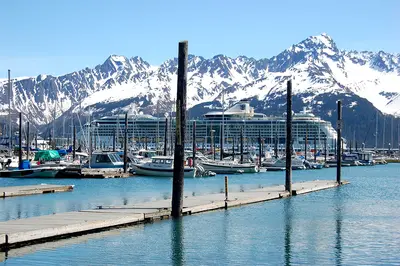
Most Royal Caribbean itineraries are round trip sailings, meaning they start and end at the same cruise port. With certain Alaska itineraries, however, you can book a one-way cruise.
One-way Alaska cruises start in Vancouver, British Columbia and travel north to Seward, Alaska (and vice versa). Like other Alaska cruises, these itineraries are 7-nights, but traveling in one direction allows guests to visit four Alaska cruise ports instead of just three.
Roundtrip Alaska cruises leaving from Seattle must make a port stop in Victoria or Prince Rupert, British Columbia. As part of the Passenger Vessel Services Act (PVSA), all foreign-flagged ships carrying passengers from one US port to another must make a stop in a foreign port prior to returning to the United States. Victoria and Prince Rupert are the most convenient ports available, as they are situated on the way to and from Alaska.
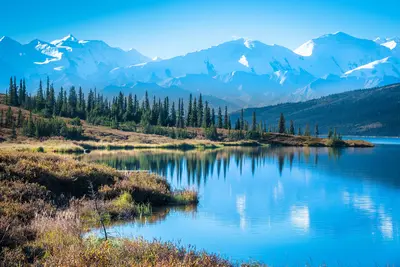
One-way itineraries do not need to stop in either of the ports since they begin or end in Vancouver, Canada. Because of this, these 7-night cruises include four port stops in Alaska instead of three, in addition to a glacier viewing day.
Because one-way itineraries start or end in Seward, you also have the opportunity to spend time in interior Alaska before or after the cruise. Extending your 7-night cruise with a few days visiting destinations like Denali National Park and Preserve and Talkeetna can make your vacation even more memorable.
Shore excursions are expensive
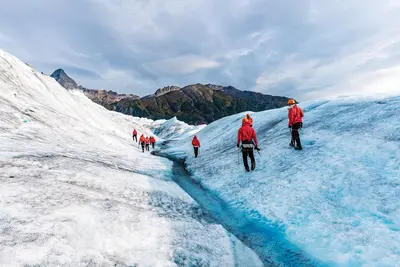
Many first-time cruisers are surprised to see how expensive shore excursions can be on an Alaska cruise. Shore excursions on Alaska cruises tend to be significantly more costly than shore excursions in the Caribbean. While you can certainly find budget-friendly tours, they are few and far between.
Expect to pay a minimum of $100 per person on Alaska shore excursions, and significantly more if you book a helicopter ride or plane to a glacier. Most whale watching tours will be at least $150-$300, and helicopter rides landing atop Mendenhall Glacier can cost well over $500 per person!
Related: Best things to do on an Alaska cruise
Despite the cost, shore excursions in Alaska offer truly unique experiences that you can’t find elsewhere in the lower 48. Whether dog sledding on a glacier or kayaking through fjords, splurging on an excursion is almost always worth it.

Nonetheless, if you don’t want to break the bank with excursions, it’s easy to have a great time in port without a shore excursion. Most Alaska cruise ports are completely walkable and offer plenty of shopping, restaurants, museums, and nature to explore without booking a tour.
To better plan your day in port, whether you book an excursion or explore on your own, check out our helpful guides:
- Local’s guide of what to do in Juneau, Alaska
- Local’s guide of what to do in Skagway, Alaska
- Top 10 things to do in Sitka, Alaska
- Local’s guide of places to visit in Ketchikan, Alaska
Last-minute deals are common in the shoulder season

More often than not, the best time to book a cruise is one to two years in advance. Booking early is generally when you’ll see the cheapest cruise fares and most stateroom options, and prices tend to only get higher closer to a cruise’s sail date.
That being said, we’ve noticed a trend with Alaska cruises in the past few years. A few months before the sailing, prices drop significantly for one-way cruise itineraries.
Related: How much does an Alaska cruise cost?
If your schedule is flexible, keep an eye out for last-minute Alaska cruises. Starting in March or April each year, search Royal Caribbean’s website for Alaska cruises and filter the search results by price. If demand is low for a particular sailing, Royal Caribbean may drop the price.

These low fares are almost always on Radiance Class ships sailing one-way itineraries from Vancouver.
These cruises see less demand due to the fact that they sail from Vancouver and that they sail one-way, as this makes travel logistics more challenging for cruisers. Plus, Radiance Class ships are significantly smaller and older than Quantum Class ships sailing to Alaska.
These “downsides” shouldn’t deter you from booking a cheap cruise to Alaska. In fact, they aren’t necessarily downsides at all! One-way cruises allow you to dig deeper into Alaska’s culture, Vancouver is a world-class city to explore before a cruise, and small ships can offer a more intimate experience than Royal Caribbean’s larger vessels.
Be prepared for itinerary changes

All Royal Caribbean cruises can be subject to itinerary changes, but you may find changes more common when sailing to Alaska.
As previously stated, Alaska’s weather can be highly unpredictable, and this may lead to itinerary changes and even port cancellations. It’s not uncommon for a port day to be canceled or moved to a different day because of inclement weather.
Royal Caribbean will do everything possible to notify guests of itinerary changes before the cruise, but sometimes you will not find out of any itinerary changes until you get onboard. Unfortunately, this may mean scrambling to figure out new shore excursions and ideas for what to do in port.
Itinerary changes also happen on glacier viewing days. If the captain deems the approach to a glacier too dangerous, whether due to icebergs or low visibility, your highly-awaited glacier viewing may be canceled.
Although most Alaska cruises go ahead as scheduled, it’s always important to remain flexible on the chance your itinerary is shifted.
Purchasing internet may not be necessary

Internet on a Royal Caribbean cruise is expensive, often costing $20 or more per day for one device. If you’re from the United States (or another country with access to US phone service), you may not need an internet package.
Related: How to get free wifi on Royal Caribbean
Depending on your itinerary, you will visit three or four ports in Alaska on your cruise. In these ports, your phone service should work as normal because you’re still in the United States. This means that during the entire port day, whether you stay onboard or get off in port, you can use your phone’s data.
If you decide against purchasing an internet package, use your time in port to catch up with friends and family, check your emails, and complete any other tasks that require an internet connection.
When you leave port and your ship begins sailing to its next destination, be sure to turn off your data and turn on airplane mode. Even though you’re sailing through Alaska’s Inside Passage, your phone data may not cover the remote areas when sailing, and you want to avoid incurring hefty data charges.
Alaska cruises have a more relaxed vibe compared to Caribbean cruises

If you’re used to weekend party cruises to the Bahamas, you might be shocked by the relaxed atmosphere on an Alaska cruise. In general, cruises to cold weather destinations tend to attract a different demographic compared to Caribbean cruises.
Whereas you might find large groups of friends onboard a 3-night Freedom of the Seas cruise for a bachelorette party, you’re more likely to see families on an Alaska cruise.
Not only that, but Alaska cruises have less of a party atmosphere compared to cruises in tropical destinations. Cruising the Caribbean is an excuse to party, whether dancing to reggae bands on the pool deck or sunbathing at all-inclusive resorts in port.
Alaska, on the other hand, is more about enjoying the state’s landscapes. You won’t find many passengers spending their day partying while in port. Instead, you’ll find them hiking, whale watching, and quietly admiring the state's gorgeous vistas.
You might feel motion sick

Many first-time cruisers are concerned about feeling seasick on a cruise, and while it’s unlikely to happen, there’s always a chance.
For the majority of an Alaska cruise, your cruise ship will sail through the calm waters of the state’s Inside Passage. As land surrounds the passage on both sides, you usually won’t encounter much movement onboard.
When your ship is not within the Inside Passage, it’s possible to encounter strong winds and high seas.
As your ship departs Seattle or Vancouver, it must sail through a brief section of the open Pacific before reaching Alaska (usually on day two of the sailing). You’ll also pass through this section on the way back to Seattle or Vancouver from Alaska (day six or seven).
Related: How to prevent seasickness on a cruise

Depending on the weather conditions, this portion of the sailing may encounter rough seas. Packing dramamine or other motion-sickness remedies is recommended just in case your ship sails through choppy waters.
If you’re on a one-way itinerary, it’s possible to encounter inclement weather while sailing through the Gulf of Alaska to (or from) Seward. Again, packing motion-sickness remedies is recommended, although you can always find some onboard if you forget.
A balcony is nice, but not necessary

When researching cruises to Alaska, one piece of advice you’ll almost always see is to book a balcony cabin. Balcony cabins are cruise staterooms with their own private outdoor balcony, and they are the most popular cabins to book on any sailing.
These rooms come at a higher cost than interior and oceanview staterooms. While the price can vary depending on the itinerary, it’s possible for balcony rooms to cost between $500 and $1000 more than the smallest interior cabins.
Related: Oceanview vs Balcony staterooms on a Royal Caribbean cruise
If a balcony won’t hurt your budget, by all means, book one for your Alaska cruise—there’s no doubt that having a balcony cabin is nice when sailing through Alaska. If booking a balcony cabin means sacrificing on other add-ons like shore excursions and drink packages, though, we recommend staying in a cheaper cabin instead.
Fortunately, Royal Caribbean designs their cruise ships with an abundance of places to enjoy ocean views without a balcony. From the pool deck to the Solarium, lounges, restaurants, and entertainment venues, you don’t have to look hard to find a scenic view while onboard.



